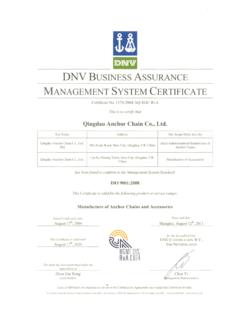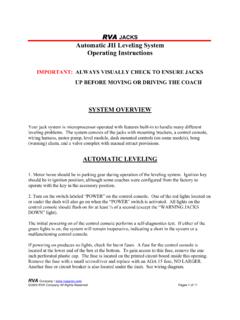Transcription of A Guide to the Analysis of Risk, Vulnerability and ...
1 A Guide to the Analysis of Risk, Vulnerability and vulnerable Groups Johannes Hoogeveen* Emil Tesliuc* Renos Vakis* with Stefan Dercon** Abstract The objectives of this paper are to provide a synthesis of current thinking and analytical approaches to risk and Vulnerability Analysis , social risk management and the Analysis of vulnerable groups, as well as to outline options for analytical work to the analyst interested in incorporating Vulnerability in poverty Analysis . The paper discusses a large number of examples, and reviews some of the analytical challenges ahead as well as the issues involved to make these approaches more relevant for local level policy Analysis . * Social Protection Unit, Human Development Network, The World Bank ** University of Oxford The views expressed in this paper are those of the authors and do not necessarily reflect those of the World Bank or any of its affiliated organizations.
2 -2- 1. Introduction and 3 2. Concepts and 4 Poverty, Risk Related Vulnerability and vulnerable 4 Social Risk Management, Social Protection and other Policy 7 3. Conducting Risk and Vulnerability 9 Setting the objectives of the 9 Sources of Vulnerability : Main 9 The 10 Appropriate Risk Management Strategies and 10 Approaches to Risk and Vulnerability Analysis : 12 The Risk and Vulnerability 13 The Evaluation of Risk-related Strategies, Arrangements and 21 4. vulnerable 25 Conceptual 25 Approaches to Studying vulnerable Groups: 25 5. The Road Ahead: new directions and analytical 31 Risk and Long-term 31 Risk as Cause of 31 Temporary Shocks and Long-term 32 Indices of 33 Summary Measures of 33 Various Vulnerability 34 Data 34 Improving survey instruments on data related to risk and vulnerable 34 Overcoming the panel syndrome.
3 34 -3-1. Introduction and Motivation Poverty Analysis typically focuses on the levels and distribution of welfare in a specific context and provides a profile of the characteristics of the poor. It is less disposed toward informing about the underlying processes that contributed to the observed levels of poverty or to clarify the reasons for poverty persistence. Many factors combine to explain the dynamics of wealth and poverty. Risk is one of these factors, and in high risk environments, characteristic of developing countries, introducing it in the analytical mix is necessary if the objective is to fully understand the dynamics by which households move in and out of poverty or remain chronically poor. In this context, risk and Vulnerability work is a natural complement to traditional poverty Analysis that can add value to the policy dialogue.
4 The Analysis of risk and Vulnerability , in the work at the World Bank and elsewhere, encapsulates two separate specific areas of attention. First, it focuses on the role of risk in the dynamics of poverty and the strategies households use to address the exposure to various sources of risks . Here, the focus is on the impact of risk on poverty, taking into account the informal and formal mechanisms of risk reduction, mitigation and coping available to households. In this paper we refer to this strand of work as risk and Vulnerability Analysis . Secondly, there is also a focus on specific vulnerable groups that are characterized by limited resilience to avoid poverty and few opportunities to escape chronic poverty. Even though risk and its consequences are not necessarily of central importance when studying vulnerable groups, there is a considerable overlap in these two areas of attention, since their limited resilience and opportunities will make vulnerable groups especially liable to further impoverishment in risky environments.
5 Furthermore, there is considerable overlap in the policy arena, whereby traditional instruments for social protection, such as targeted transfers, can both be used as a springboard, that allows households to take advantage of opportunities for wealth creation while being protected against risk-induced hardship, as well as for the protection of vulnerable groups suffering chronic impoverishment. This paper has three objectives. First, to provide a synthesis on thinking and analytical approaches to risk and Vulnerability Analysis , social risk management and the Analysis of vulnerable groups. Secondly, to offer guidance to the analyst interested in incorporating Vulnerability in poverty Analysis and by presenting a typology of possible approaches. Thirdly, it lays the foundations for further work by critically examining the core issues and challenges involved in making these approaches more relevant for policy dialogue.
6 The paper is organized as follows. Section 2 revisits some of the core concepts involved in work on Vulnerability , and its link to poverty. Section 3 outlines the key conceptual steps required to conduct risk and Vulnerability Analysis , and provides a review of potential approaches based on recent examples. Section 4 focuses on the Analysis of specific and identifiable vulnerable groups. Section 5 focuses on the road ahead, introducing some outstanding issues and core challenges, and the way they may inform local level policy making. -4- 2. Concepts and Definitions The literature on risk, Vulnerability and poverty is both broad and extensive. It is therefore natural that differences exist in how one defines a concept such as Vulnerability or even poverty, and how one explores the relationship between risk and poverty.
7 As such, this section defines these concepts as they are used in the paper. First, we will dwell on the linkages between poverty and risk. The terms Vulnerability or vulnerable groups are commonly used, but often with different meanings by different practitioners, even within the World Bank. In particular, we will make a distinction between risk-related Vulnerability to poverty and vulnerable groups whose chronic poverty requires specific attention. Secondly, we will revisit the policy agenda as it has been developed to deal with Vulnerability , including social protection (SP) and social risk management (SRM) approaches. Poverty, Risk Related Vulnerability and vulnerable Groups Poverty encompasses more than low income or consumption Deprivation is often related to income poverty, for instance when low income prevents people to achieve sufficient nutrition or to obtain remedies for treatable illnesses.
8 But not always is poverty closely related to income. It may also come from a lack of access to public facilities and programs (such as health or education) or from the denial of political, civil and economic liberties. Exposure to risk may be seen as one of the many dimensions of poverty. Poor households are typically more exposed to risk and least protected from it. This exposure has a direct bearing on well-being. Perhaps even more important is how risk exposure causes poverty or increases the depth of poverty. In an attempt to avoid risk exposure, households may take costly preventive measures, which in turn, contribute to poverty. The decision not to invest in a high risk but high return activity not only means foregone income but also a higher likelihood that a household is poor. If security concerns force parents to take children out of school, this disenfranchises the children from their right to basic education.
9 And, if credit and insurance markets are poorly developed, exposure to risks may induce households to hold portfolios of assets that, while possibly well suited to buffering consumption, are not necessarily the most productive. The direction of causation can also be reversed so that poverty causes exposure to risk. For instance, to avoid extreme income poverty or food insecurity a household may choose to cultivate in insecure areas (land infested with land mines, or areas where rebels are active) or to live in an unhealthy or unsafe environment (landslides, railroad track). It is not only exposure to risks that may lead to unacceptable outcomes in well-being. The manifestation of risk (as a shock) also leads to undesirable welfare outcomes. Apart from the physical and psychological consequences for well-being from experiencing a shock, its consequences can be highly undesirable.
10 A shock can push an already income poor household further into poverty, or drive a non-poor household below the income poverty 1 Sen (1999), Narayan et al. (2000), and World Development Report (2000). -5-line. A shock can be the reason why children are taken out of school, affect people s health permanently or reduce life expectancy. Clearly, if households have the option to insure against the negative consequences of shocks, risk will have a limited impact on welfare. It is therefore exposure to uninsured risk that causes undesirable welfare outcomes such as income poverty, malnutrition, low education levels or low life expectancy. These linkages between poverty and risk define the concept of Vulnerability . In particular, whereas poverty reflects an unacceptable level of well-being, (risk-related) Vulnerability is defined as.
















